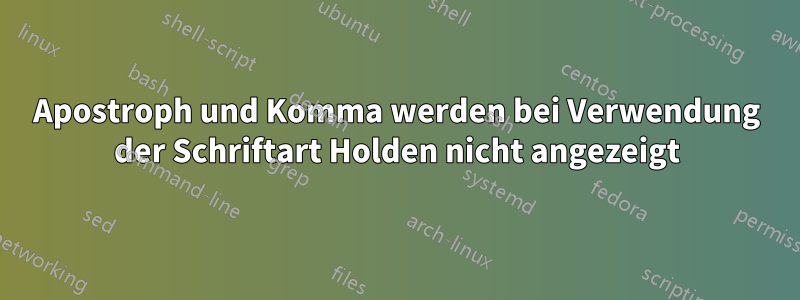
In einer normalen Schriftart, z. B. einer modernen Standardschriftart für Computer, erscheint in der Ausgabe ein Apostroph und ein Komma. Aber wenn ich die Schriftart Holden verwende, \setmainfont{Holden}erscheint in der Ausgabe kein Apostroph und kein Komma.
Mein Code ist -
\documentclass[12pt]{article}
\usepackage[a4paper,left=1cm,right=1cm,top=1cm,bottom=1cm]{geometry}
\usepackage{fontspec}
\usepackage[dvipsnames]{xcolor}
\usepackage[object=vectorian]{pgfornament} % also loads tikz
\setmainfont{Holden}
\tikzset{pgfornamentstyle/.style={draw = Periwinkle,
fill = SpringGreen}}
\usetikzlibrary{
positioning, % for left=of, above=of etc.
calc % for let syntax used in second example
}
\begin{document}
\begin{center}
\begin{tikzpicture}[
every node/.append style={inner sep=0},
node distance=5mm
]
\node [Black] (text){Vaijan's Honey};
\path
let
\p1=(text.south west),
\p2=(text.north east),
\n1={\x2-\x1}, % width of text node
\n2={\y2-\y1} % height of text node
in
% in all of the below some fraction of \n1 or \n2 is used to define the width of the ornaments
% set width of these ornaments to half the text node's width
node [anchor=north] (below) at (text.south) {\pgfornament[width=0.5*\n1,symmetry=c]{69}}
node [anchor=south] (above) at (text.north) {\pgfornament[width=0.5*\n1]{69}}
% use \n2 for ornament width here
node [rotate=-90, left=of text, anchor=north] (left) {\pgfornament[width=\n2]{46}}
node [rotate=90, right=of text, anchor=north] (right) {\pgfornament[width=\n2]{46}}
% and \n1 here
node [above=of above] (top) {\pgfornament[width=\n1]{71}}
node [below=of below] (bottom) {\pgfornament[width=\n1,symmetry=h]{71}}
% node [anchor=north] (top) at (text.north) {\pgfornament[width=\n1]{71}}
% node [anchor=south] (bottom) at (text.south) {\pgfornament[width=\n1,symmetry=h]{71}}
% and 25% of width for the corner ornaments
node [anchor=north west] at (top.north -| left.south) {\pgfornament[width=0.25*\n1]{63}}
node [anchor=north east] at (top.north -| right.south) {\pgfornament[width=0.25*\n1,symmetry=v]{63}}
node [anchor=south west] at (bottom.south -| left.south) {\pgfornament[width=0.25*\n1,symmetry=h]{63}}
node [anchor=south east] at (bottom.south -| right.south) {\pgfornament[width=0.25*\n1,symmetry=c]{63}}; % <- note the \path doesn't end until here
% draw frame
\draw [Blue] (current bounding box.south west) rectangle (current bounding box.north east);
\vspace{2cm};
\node [anchor=south] (bellowaddress1) at (below.south) {\pgfornament[width=0.10*\textwidth]{88}};
\setmainfont{Linux Biolinum O}
\tiny
\node [Brown, below, align=center] (bellowaddress3) at (bellowaddress1.south) {Md.Al-Helal, CSE, DU\\ 01515611989};
\node [anchor=south, below] (bellowaddress2) at (bellowaddress3.south) {\pgfornament[width=0.10*\textwidth]{88}};
\end{tikzpicture}
\end{center}
\end{document}
Antwort1
Offenbar ist die Zuordnung für diese Schriftart nicht ganz korrekt. Im Protokoll steht:
Missing character: There is no ’ in font [Holden.otf]/OT:mapping=tex-text;!
Das Zeichen ist jedoch vorhanden, wie in FontForge zu sehen ist:
FontForge zeigt den Namen des Zeichens an "quotesingle". Dies kann für das Makro verwendet werden, \XeTeXglyphindexum die Indexnummer zu finden, mit der das Zeichen gedruckt werden kann:
\documentclass[12pt]{article}
\usepackage{fontspec}
\setmainfont{Holden.otf}
\begin{document}
The apostrophe is at position: \the\XeTeXglyphindex"quotesingle"
Printed: \XeTeXglyph83
\end{document}
Beachten Sie, dass hier die .otfSchriftart verwendet wird, die Funktion jedoch für die Version gleich ist .ttf.
Angewandt auf Ihr MWE:
\node [Black] (text){Vaijan\XeTeXglyph83 s Honey};
Antwort2
Schriftarten werden standardmäßig mit geladen Ligatures=TeX. Diese Funktion wird 'in U+2019 neu zugeordnet, aber anscheinend hat die Schriftart Holden an dieser Stelle kein Glyph. Im Gegenteil, ihr Apostroph an der Standard-ASCII-Position ist geschweift.
Laden Sie die Schriftart einfach ohne Ligatures=TeX.
\documentclass[12pt]{article}
\usepackage[a4paper,left=1cm,right=1cm,top=1cm,bottom=1cm]{geometry}
\usepackage{fontspec}
\usepackage[dvipsnames]{xcolor}
\usepackage[object=vectorian]{pgfornament} % also loads tikz
\newfontface{\holdenfont}{Holden}[
Path=./,
Extension=.otf,
Ligatures=,
]
\tikzset{pgfornamentstyle/.style={draw = Periwinkle,
fill = SpringGreen}}
\usetikzlibrary{
positioning, % for left=of, above=of etc.
calc % for let syntax used in second example
}
\begin{document}
\begin{center}
\begin{tikzpicture}[
every node/.append style={inner sep=0},
node distance=5mm
]
\node [Black] (text){\holdenfont Vaijan's Honey};
\path
let
\p1=(text.south west),
\p2=(text.north east),
\n1={\x2-\x1}, % width of text node
\n2={\y2-\y1} % height of text node
in
% in all of the below some fraction of \n1 or \n2 is used to define the width of the ornaments
% set width of these ornaments to half the text node's width
node [anchor=north] (below) at (text.south) {\pgfornament[width=0.5*\n1,symmetry=c]{69}}
node [anchor=south] (above) at (text.north) {\pgfornament[width=0.5*\n1]{69}}
% use \n2 for ornament width here
node [rotate=-90, left=of text, anchor=north] (left) {\pgfornament[width=\n2]{46}}
node [rotate=90, right=of text, anchor=north] (right) {\pgfornament[width=\n2]{46}}
% and \n1 here
node [above=of above] (top) {\pgfornament[width=\n1]{71}}
node [below=of below] (bottom) {\pgfornament[width=\n1,symmetry=h]{71}}
% node [anchor=north] (top) at (text.north) {\pgfornament[width=\n1]{71}}
% node [anchor=south] (bottom) at (text.south) {\pgfornament[width=\n1,symmetry=h]{71}}
% and 25% of width for the corner ornaments
node [anchor=north west] at (top.north -| left.south) {\pgfornament[width=0.25*\n1]{63}}
node [anchor=north east] at (top.north -| right.south) {\pgfornament[width=0.25*\n1,symmetry=v]{63}}
node [anchor=south west] at (bottom.south -| left.south) {\pgfornament[width=0.25*\n1,symmetry=h]{63}}
node [anchor=south east] at (bottom.south -| right.south) {\pgfornament[width=0.25*\n1,symmetry=c]{63}}; % <- note the \path doesn't end until here
% draw frame
\draw [Blue] (current bounding box.south west) rectangle (current bounding box.north east);
\vspace{2cm};
\node [anchor=south] (bellowaddress1) at (below.south) {\pgfornament[width=0.10*\textwidth]{88}};
\setmainfont{Linux Biolinum O}
\tiny
\node [Brown, below, align=center] (bellowaddress3) at (bellowaddress1.south) {Md.Al-Helal, CSE, DU\\ 01515611989};
\node [anchor=south, below] (bellowaddress2) at (bellowaddress3.south) {\pgfornament[width=0.10*\textwidth]{88}};
\end{tikzpicture}
\end{center}
\end{document}
Ich habe es nicht als Hauptschriftart geladen und den Pfad und die Erweiterung angegeben, nur um es an mein Setup anzupassen (ich möchte sicher nicht, dass diese Schriftart meine Systemschriftarten überlagert







